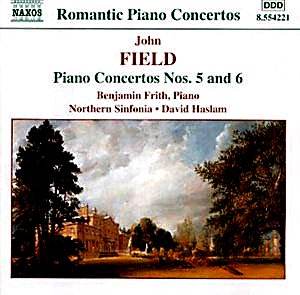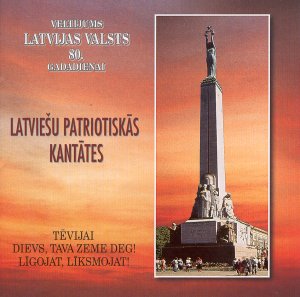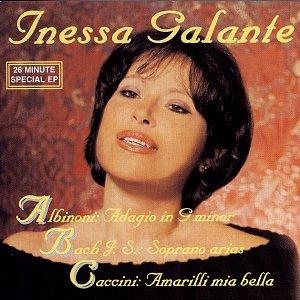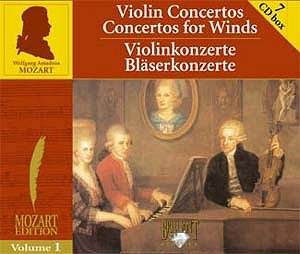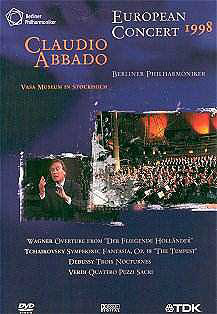 Composer: Richard Wagner, Peter Ilyich Tchaikovsky, Claude Debussy, Giuseppe Verdi
Composer: Richard Wagner, Peter Ilyich Tchaikovsky, Claude Debussy, Giuseppe Verdi
Works: The Flying Dutchman – Overture (1843), The Tempest, Op. 18 (1873), Three Nocturnes (1900), Quattro Pezzi Sacri (1898)
Performers: Berlin Philharmonic Orchestra, Swedish Radio Choir, Eric Ericson Chamber Choir, conducted by Claudio Abbado
Recording: Live performance from the Vasa Museum, Stockholm, May 1, 1998
Label: Deutsche Grammophon
The 1998 European Concert recorded at the Vasa Museum is a remarkable illustration of how the venue can enhance the thematic resonance of the music performed within its walls. The evening features an illustrious lineup of works by Wagner, Tchaikovsky, Debussy, and Verdi, each selected for its evocative power and historical significance. The Vasa, a 17th-century warship, serves as a striking backdrop, reinforcing the grandeur of Wagner’s narratives and the emotional depth of the selected repertoire.
Claudio Abbado, a maestro renowned for his interpretative sensitivity, leads the Berlin Philharmonic Orchestra with a deft hand. The concert opens with Wagner’s Overture to The Flying Dutchman, and Abbado’s reading captures the brooding atmosphere inherent in Wagner’s score. The orchestra plays with a lushness that evokes the tempestuous seas of the Dutchman’s fateful journey. The dramatic tension builds seamlessly, enhanced by the striking visual imagery of the Vasa illuminated against the night sky. While Abbado may not reach the visceral intensity of Herbert von Karajan’s most electrifying interpretations, his nuanced phrasing and dynamic control establish a compelling narrative arc, particularly evident in the climactic moments when the strings soar above the brass, creating a palpable sense of longing.
Tchaikovsky’s The Tempest follows, and Abbado’s familiarity with this work shines through. The conductor’s expressive gestures invite the orchestra to explore the score’s emotional landscape. The performance is marked by a vibrant interplay between sections, particularly during the Allegro agitato, where the strings and woodwinds engage in a lively dialogue that feels both spontaneous and tightly structured. The enjoyment evident on Abbado’s face adds a layer of warmth to the performance, making it feel less like a routine execution and more like a shared experience of musical discovery.
Debussy’s Three Nocturnes offers a contrast in texture and sound world, and the addition of the Swedish Radio Choir brings an ethereal quality to the performance. Abbado takes advantage of the live setting, allowing for a degree of risk that studio recordings often lack. The shimmering sonorities of “Nuages” are beautifully rendered, with the delicate interplay of harp and strings creating a dreamlike atmosphere. This ethereality is complemented by the robust choral contributions in “Sirènes,” where the choir’s clear, youthful tone resonates vividly against the orchestral backdrop, establishing a striking contrast that showcases the fluidity of Debussy’s harmonic language.
Verdi’s Quattro Pezzi Sacri serves as a powerful conclusion to the concert, and Abbado’s adeptness in choral repertoire is evident. The performances of these sacred pieces are imbued with both solemnity and fervor. The Swedish choirs articulate the Latin text with clarity and sonorous richness, while the orchestra provides a lush, supportive foundation. Abbado’s interpretation is both respectful of Verdi’s intentions and infused with a contemporary awareness of the music’s dramatic potential, particularly in the “Ave Maria,” where the choir and orchestra intertwine with exquisite balance.
Sound quality is exemplary, capturing the vibrant acoustics of the Vasa Museum and the nuanced details of the performance. The engineering allows for an immersive listening experience, whether in the crescendos of Wagner or the intimate moments of Debussy. Each musical line is clearly defined, providing listeners with a complete understanding of the orchestral and choral textures.
This DVD is a treasure not only for its musical content but also for its visual presentation. Bob Coles’ direction enhances the experience, utilizing the Vasa’s historical significance and visual splendor to elevate the concert. The interplay of light and music creates a memorable aesthetic that resonates long after the final note has sounded.
What emerges from this performance is a profound sense of connection between historical context and musical interpretation. The choices made by Abbado and the musicians reflect a deep understanding of the repertoire, resulting in a concert that is as intellectually satisfying as it is emotionally engaging. This recording stands as a testament to the enduring power of live music, captured in a setting that is both beautiful and historically rich.
